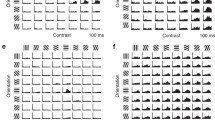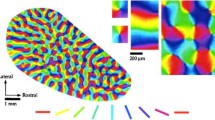Abstract
We describe a new theoretical scenario for the development of orientation selective cells in a self-organizing feedforward network with modifiable synapses. A suitable choice of Hebb rule leads to a system that develops symmetric and antisymmetric response fields (quadrature pairs) at the same time as directional selectivity occurs using inhibition between neighboring cells. Quadrature phase relationships between the response properties of adjacent cortical cells is suggestive of several highly efficient information processing strategies.
Similar content being viewed by others
References
Barlow H (1981) Critical limiting factors in the design of the eye and visual cortex. Proc R Soc B 212:1–34
Carew TJ, Hawkins RD, Abrams TW, Kandel ER (1984) A test of Hebb's postulate at identified synapses which mediate classical conditioning in Aplysia. J Neurosci 4:1217–1224
Coleman S (1985) Aspects of symmetry, chap 5. Cambridge University Press, Cambridge, pp 113–184
Cooper LN, Liberman F, Oja E (1979) A theory for the acquisition and loss of neuron specificity in visual cortex. Biol Cybern 33:9–28
Daugman JG (1985) Uncertainty relation for resolution in space, spatial frequency, and orientation optimized by twodimensional visual cortical filters. J Opt Soc Am A 2:1160–1169
Gabor D (1946) Theory of communication. J Inst Electr 93:429–457
Grzywacz NM, Yuille AL (1989) A model for the estimate of local image velocity by leus in the visual cortex. Harvard Robotics Laboratory Memo 1989
Hebb DO (1949) The organization of behavior. Wiley, New York
Heeger D (1987) Model for the extraction of image flow. J Opt Soc Am A 4:1455–1471
Hopfield JJ (1984) Neurons with graded response have collective computational properties like those of two-state neurons. Proc Natl Acad Sci USA 81:3088–3092
Jahr CE, Stevens CF (1987) Glutamate activates multiple single channel conductances in hippocampal neurons. Nature 325:522–525
Jones J, Palmer L (1987) The two-dimensional spatial structure of simple receptive fields in cat striate cortex. J Neurophys 58:1233–1258
Kammen DM (1988) Self-organization in neural networks. Ph. D. Thesis, Harvard University
Kammen DM, Yuille AL (1988) Spontaneous symmetry-breaking energy functions of orientation selective cortical cells. Biol Cybern 59:23–31
Kersten D (1988) Private communication
Linsker R (1986a) From basic network principles to neural architecture: emergence of spatial-opponent cells. Proc Natl Acad Sci USA 83:508–512
Linsker R (1986b) From basic network principles to neural architecture: emergence of orientation-selective cells. Proc Natl Acad Sci USA 83:8390–8394
Linsker R (1986c) From basic network principles to neural architecture: emergence of orientation columns. Proc Natl Acad Sci USA 83:8779–9783
Linsker R (1988) Private communication
Linsker R (1988) Self-organization in a perceptual network. Computer 105–117
Miles R, Wong RKS (1987) Latent synaptic pathways revealed after tetanic stimulation in the hippocampus. Nature 329:724–726
Oja E (1982) A simplified neuron model as a principal component analyzer. J Math Biol 15:267–273
Pollen D, Ronner S (1981) Phase relationships between adjacent simple cells in the visual cortex. Science 212:1409–1411
Sanger T (1988) Optimal unsupervised learning in a single-layer linear feedforward network. Neur Netw
Sattinger DH (1979) Group theoretic methods in bifurcation theory. Lecture Notes in Mathematics, vol 762. Springer, Berlin Heidelberg New York
Schall JD, Leventhal AG (1987) Relationships between ganglion cell dendritic structure and retinal topography in the cat. J Comp Neurol 257:149–159
Schall JD, Perry VH, Leventhal AG (1986a) Retinal ganglion cell dendritic fields in Old-World monkeys are oriented radially. Brain Res 368:18–23
Schall JD, Vitek DJ, Leventhal AG (1986b) Retinal constraints on orientation specificity in cat visual cortex. J Neurosci 6:823–836
Sillito AM (1987) Synaptic processes and neurotransmitters operating in the central visual system: a system approach. In: Edelman G, Gall E, Cowan M (eds) Synaptic function. Wiley, New York, pp 328–371
Spiro P (1987) Receptive field shape as a function of dimensionality reduction and image statistics. B.S. Thesis, MIT (unpublished)
Vidyasagar TR, Urbas JV (1982) Orientation sensitivity of cat LGN neurones with and without inputs from visual cortical areas. Exp Brain Res 46:157–169
Author information
Authors and Affiliations
Additional information
D. M. Kammen performed this work while in the Department of Physics, Harvard University
Rights and permissions
About this article
Cite this article
Yuille, A.L., Kammen, D.M. & Cohen, D.S. Quadrature and the development of orientation selective cortical cells by Hebb rules. Biol. Cybern. 61, 183–194 (1989). https://doi.org/10.1007/BF00198765
Received:
Accepted:
Issue Date:
DOI: https://doi.org/10.1007/BF00198765




